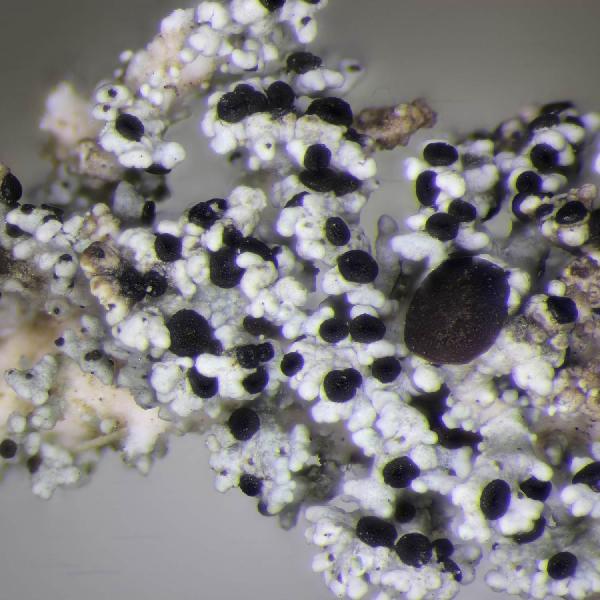Scutula stereocaulorum (Anzi) Körb.
Parerga Lichenol., 5: 455, 1865. Basionym: Lecidea stereocaulorum Anzi - Comm. Soc. Crittog. Ital., 1, 3: 155, 1862.
Synonyms: Biatorina stereocaulorum (Anzi) Jatta; Catillaria stereocaulorum (Th. Fr.) H. Olivier; Spilodium stereocaulorum (Anzi) Nieuwl.
Distribution: N - TAA (Brackel 2016), Lomb (Brackel 2016), Piem (Brackel 2016).
Description: Thallus absent, not lichenized, developing on the thalli of Stereocaulon-species, causing little damage to the host thalli. Apothecia lecideine, 0.1-0.8 mm across, at first dark red-brown, then black, with a flat o finally convex disc and a persistent or finally excluded proper margin. Proper exciple of parallel, radiating, branched and anastomosing, strongly adglutinated hyphae, dark reddish brown; epithecium reddish brown, sometimes with an orange or red hue, 5–10 μm high; hymenium colourless or pale yellowish brown, (35-)50-80 µm high, the hymenial gel hemiamyloid; paraphyses septate, very sparingly branched and anastomosing, the apical cells thickened, 4-8 µm wide, with a dark cap; hypothecium colourless to brown, of loosely intertwined hyphae, 100–250 μm high, I+ and K/I+ blue-violet, with greenish yellow inclusions reacting K+ orange-red. Asci 8-spored, with an amyloid tholus, a diffuse non-amyloid apical cushion, and an outer amyloid wall layer. Ascospores (0-)1-septate, not constricted at septum, hyaline, narrowly ellipsoid to narrowly oblong, (10.5-)13-17(-19) x (3.5–)4-5.5(-6.5) μm, thin-walled, without a perispore. Pycnidia brown, cupuliform, 50-130 μm in diam., immersed. Conidia simple, hyaline, falcate to bacilliform, (8-)10-12.5(-13.5) x 1-1.5 μm. Photobiont absent. Spot tests: K-, C-, KC-, P-, UV-. Chemistry: thallus without lichen substances; apothecia with different pigments.Note: a mainly arctic-alpine, non-lichenized lichenicolous fungus growing on the thalli of Stereocaulon-species, also known from the mountains of Macaronesia. Perhaps more widespread in the Alps and to be looked for also in Southern Italy (e.g. on the Vesuvius). The description mainly follows Zhurbenko (2010).
Growth form: Lichenicolous fungus
Substrata: rocks, soil, terricolous mosses, and plant debris
Reproductive strategy: mainly sexual
Commonnes-rarity: (info)
Alpine belt: very rare
Subalpine belt: very rare
Oromediterranean belt: absent
Montane belt: absent
Submediterranean belt: absent
Padanian area: absent
Humid submediterranean belt: absent
Humid mediterranean belt: absent
Dry mediterranean belt: absent

Predictive model
Herbarium samples

Source: https://fungi.myspecies.info/all-fungi/catillaria-stereocaulorum Photo uploaded by Paul Cannon - CC BY NC
Catillaria stereocaulorum, infected thallus of the host lichen Stereocaulon dactylophyllum, covered in minute black apothecia; those of the host are larger and dark brown. Collection from soil over mine spoil, VC97 W Inverness.
Growth form: Lichenicolous fungus
Substrata: rocks, soil, terricolous mosses, and plant debris
Reproductive strategy: mainly sexual
Commonnes-rarity: (info)
Alpine belt: very rare
Subalpine belt: very rare
Oromediterranean belt: absent
Montane belt: absent
Submediterranean belt: absent
Padanian area: absent
Humid submediterranean belt: absent
Humid mediterranean belt: absent
Dry mediterranean belt: absent

Predictive model
| Herbarium samples |

 DOLICHENS
DOLICHENS

